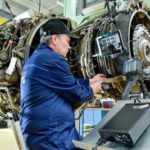We hear a lot about the circular economy in areas such as smart cities. It has a lot of potential for aerospace too, as we learn from Christina Fagin, industrial designer and circular economy expert.
The circular economy is about “value preservation,” Fagin says.
She explains: “When we build products, we build up value through the input and material, and energy in the labour. So once the product is off from production into retail then we have the climax of the product’s value and after that, starting with the use phase, the value decreases really quickly.”
Fagin notes that the way we use products is also quite inefficient – many cars are in driveways or parked 90% of the time, for example. The circular economy looks at how we can use our products more efficiently through sharing, for example, and using products for longer. It’s also about recycling products and their materials at the end of their life.
Aerospace’s locked-in value
Fagin says: “In aerospace you have lots of valuable material locked in, in an aeroplane, and you have different durabilities. That means you also have the possibility for different business models.”
Parts can be leased out, for instance. Fagin gives the example of Rolls Royce: “They lease the turbines and they take care of the maintenance. They take care of the whole service – the airline just pays for an always-functioning turbine. So we have a leasing model where Rolls Royce [for example] retains ownership over the turbine and can reuse the whole material in the end and take care of the maintenance between.”
Aerospace must do more
Aerospace faces significant challenges in fully capitalising on the circular economy but must find ways to do a lot more, Fagin says.
“I think right now there’s only a little that’s been done,” she comments. “Especially since the pressure and the regulations in the air industry are really, really tight. You have a lot of pressure to [be] as lightweight, as possible. You have a lot of security regulations. That is really a great barrier but we want to push against that.”
She adds: “ We have only one planet and the resources that we have; they are finite.”
One area of potential, Fagin, says is food in aircraft cabins.
“If you could make all the material, all the waste that accumulates during a flight, from one material, then you could easily recycle that because you know what kind of material it is, but [now] we have a whole mixture of materials, and that makes it really difficult to recycle it at a high level.”

